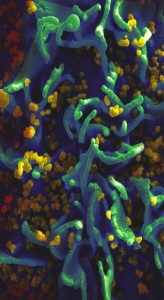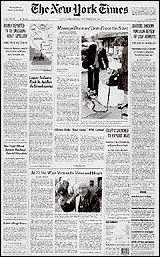2013 AIDS Chronicles Release



The Institute of Cultural Inquiry (ICI) is pleased to announce the online publication of the 2013 AIDS Chronicle, the first digital edition of their longest ongoing project, the AIDS Chronicles, which brings attention to the AIDS pandemic through targeted, art-based activism.
The AIDS Chronicles were initiated in 1993, at the height of the AIDS pandemic in the United States, to create a record of the day-to-day discourse on AIDS and HIV in what is often referred to as the US “newspaper of record,” the New York Times. The goal of the project is simple—to subvert the newspaper’s usual hierarchy of focus in a way that narrows the reader’s attention to just one issue – the newspaper’s (lack of) reporting about the spread of the HIV virus and the global AIDS pandemic.

Each yearly AIDS Chronicle consists of 365 front pages from the New York Times, collected from December 1 (World AIDS Day) to November 30 (of the following year) that have been treated on both sides with three layers of acrylic paint to produce tangible, blood-red sheets that leave visible only images or articles that mention AIDS or HIV, along with the folio showing the date of publication, and the ‘obituaries’ (or in their absence a blank box) in the newspaper’s index as a direct reference to the listing of AIDS-related deaths deep inside the newspaper. The various artist ‘bound’ editions of the AIDS Chronicles are on permanent display in the ICI Library and are often shown publicly on December 1st to commemorate World AIDS Day and the Day With[out] Art.
This year the ICI is publishing the 2013 AIDS Chronicle as a digital document, a virtual edition made possible after the New York Times began to offer high-resolution, downloadable PDFs of their daily front page in the summer of 2012. The digital publication, produced by the ICI’s Assistant Director and independent curator, Sue-Na Gay, will be divided into three volumes to facilitate download and interaction with cover images that capture both the horror and beauty of the HIV virus. The covers present the viewer with an up close and personal look at the HIV virus on a microscopic scale, shedding light on the virus’s destructive biological implications, while at the same time aesthetically blurring it into abstraction. Here, the disease is at once wholly present and yet still ‘flying under the radar’ to the untrained eye thus mirroring the coverage of the disease process in the media.

New York Public Library, 1998

Sam Francis Gallery at Crossroads School, 2003
Over the years, pages of the AIDS Chronicles have been displayed in a variety of forms. As unbound, loose sheets, they have been shown covering walls or windows as an expansive and overwhelming document. In book form, the Chronicles have been displayed on a lectern or pedestal where volunteers from the community turn the pages to the sound of a gong that is hit at the rate of worldwide AIDS deaths for the year preceding the display. Each presentation has allowed viewers to study the information published by this prominent U.S. newspaper and encouraged them to reflect on the types of articles and the kind of attention and information the continuing pandemic is given. At the same time, the display of the pages in their repetitive, minimalist simplicity has allowed for quiet contemplation in order to remember those individuals who have been lost to the disease.
Since its inception, the Chronicles have quietly and self-reflectively ‘indexed’ the New York Times‘ reports on the spread of the HIV virus. The painted pages have endured to bear witness to the long decades when the virus jumped to Africa and Southeast Asia, when drug companies found financial opportunities in drugs meant to treat (but not cure) HIV, and when the virus turned into a cause célèbre fashion statement. The Chronicles continue to keep vigil to this day as nations push for -0- infection rates, reminding us that even though the Times has chosen to minimize its reporting on the AIDS virus, a choice evidenced by their daily, front page coverage of the 2014 Ebola epidemic in Africa, the newspaper did once report on hopes for a real cure and a real vaccine not just on expensive treatments that promise a life with the virus.

After twenty-two years, the AIDS Chronicles has met the ICI’s goal to produce a historical record of AIDS reporting in the New York Times but it has also created another unanticipated record, a collective document drawn from a different kind of AIDS reporting. That document is forged in the areas of pages that hold no AIDS/HIV articles; in the weight of those pages as they sit in silent tomes; in the residue left by human hands that touch their skin-like surfaces; in the small rips and tears that result from their ritualized turning; and especially in their seemingly unending supply. Their blood-red, cockled surfaces speak of the blood that carries the virus, of the fear of that blood, of passion, of pain over the loss of passion, of anger, of a rage that ‘sees red,’ and of the shame of having blood on one’s hands—of being caught red handed. The language of this other AIDS record comes not from the printed press but from the private, lived experience of loss, of anger, of shame.
With its dual ability to operate as a record of public notice and as a document of private experience, the AIDS Chronicles project enters a new chapter as one of its tomes becomes an ambassador of AIDS activism on the Internet, albeit with new and different forms. Given that the digital publication of the 2013 AIDS Chronicle is a weightless  document entering the timeless datascape of the Internet, it will have to find its power in other news-gathering traditions, its activism through other unnoticed trap doors. Online, the document will not be restricted to the United States and Europe, (to date the only locations the AIDS Chronicles have been shown); it will potentially reach a global audience that includes those populations that continue to be most affected by the AIDS pandemic. With a publication url that includes a fragment of the New York Times own digital address, the 2013 Chronicle will shadow the digital pages of the 2013 Times as it travels through Google search pages, like a talkative hitchhiker that is always ‘going wherever you’re going.’ The small box on each page that wraps around the word obituary, or blankly represents it, will become more than an abstract symbol of loss and shame. Online, the deaths the obituary boxes represent will be linked to ‘tags’ that carry the names of actual individuals whose obituaries were once printed inside the newspaper even as the Times kept the front page free of any mention of the virus that killed them. Widgets and SEO options give context and history to the Times‘ engagement with HIV and AIDS as ‘digital stowaways’ that help ‘right’ the pages that ACT-UP once said, when it came to AIDS reporting, were ‘out of order.’
document entering the timeless datascape of the Internet, it will have to find its power in other news-gathering traditions, its activism through other unnoticed trap doors. Online, the document will not be restricted to the United States and Europe, (to date the only locations the AIDS Chronicles have been shown); it will potentially reach a global audience that includes those populations that continue to be most affected by the AIDS pandemic. With a publication url that includes a fragment of the New York Times own digital address, the 2013 Chronicle will shadow the digital pages of the 2013 Times as it travels through Google search pages, like a talkative hitchhiker that is always ‘going wherever you’re going.’ The small box on each page that wraps around the word obituary, or blankly represents it, will become more than an abstract symbol of loss and shame. Online, the deaths the obituary boxes represent will be linked to ‘tags’ that carry the names of actual individuals whose obituaries were once printed inside the newspaper even as the Times kept the front page free of any mention of the virus that killed them. Widgets and SEO options give context and history to the Times‘ engagement with HIV and AIDS as ‘digital stowaways’ that help ‘right’ the pages that ACT-UP once said, when it came to AIDS reporting, were ‘out of order.’
On December 1, 2015, the 2013 AIDS Chronicle will be published as a digital three-volume tome. At the same time, the 365 pages will become raw material in the virtual space of the unfinished, the unrepaired, and the unretrieved where, instead of collecting dust and silverfish in the ICI Library, they can help draw new hypotheses for a yet unknowable future.
# # #
Sue-Na Gay also designed the archive box that will hold the original 2013 newsprint documents and a specially designed jump drive that will carry the data information and documentation of the digital publication. This archive box will be deposited in the ICI Library with other versions of the AIDS Chronicles and will be available to the public by appointment throughout the year. All three digital volumes of the 2013 AIDS Chronicles will remain on display via the Institute’s multi-faceted online presence.
A downloadable pdf version of the press release can be found here.
(1.2 mb; updated 02/22/2017)


